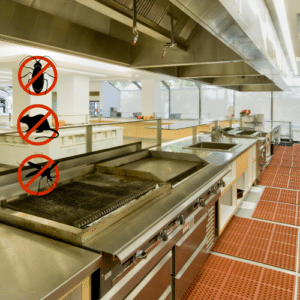
15 Aug Pests in Your Commercial Kitchen
Pests in Commercial Kitchens
Managing pests in a commercial kitchen is crucial for maintaining food safety and business reputation. As a family-owned, organic pest control company based in South Florida, we understand the unique challenges local businesses face. From rodents to insects, keeping pests at bay is essential for a clean, safe, and hygienic kitchen environment.
Rodents are among the most common pests in commercial kitchens. Mice and rats are attracted to the abundant food sources and warm environments typical of kitchen areas. Mice can squeeze through surprisingly small gaps, while rats are larger and require more substantial openings. These rodents are notorious for their ability to contaminate food, spread diseases, and cause structural damage by gnawing on pipes and wiring.
To combat rodent infestations, it’s crucial to understand their behavior. Mice are more likely to invade kitchens seeking food, while rats are often in search of shelter. Effective rodent management involves sealing entry points, maintaining cleanliness, and setting traps or bait stations. Regular inspections can help detect signs of rodent activity early, allowing for timely intervention.
Managing Kitchen Bugs
Insects such as cockroaches, flies, and ants can also create significant problems in commercial kitchens. Cockroaches are particularly troublesome, as they can spread pathogens and thrive in the dark, moist environments often found in kitchens. Flies are attracted to food waste and can transfer bacteria from one surface to another. Ants, while often less concerning than cockroaches, can quickly become a nuisance if they establish a colony near food sources.
Cockroaches can be managed by eliminating their hiding spots and ensuring that all food is stored in sealed containers. Flies can be kept away by covering trash bins and cleaning up spills promptly. Ants require a more detailed approach, including identifying and eliminating their food sources and sealing any entry points.
A clean kitchen is the first line of defense against pests. Daily cleaning routines are essential for preventing infestations. This includes wiping down surfaces, cleaning floors, and ensuring that no food debris is left behind. Proper food storage is also critical. Store all food in airtight containers to prevent pests from accessing it. Trash bins should be emptied regularly, and the kitchen should be deep cleaned periodically to remove any potential attractants for pests.
Deep cleaning involves more than just regular tidying. It includes scrubbing floors and walls, cleaning behind appliances, and addressing any spills or leaks that might attract pests. Ensuring that all areas of the kitchen are thoroughly cleaned will help reduce the likelihood of pests finding a suitable environment to thrive.
Regular Pest Checkups
Routine inspections are vital for early detection of pest issues. Regularly check for signs of pests, such as droppings, nests, or damaged packaging. Using pest monitoring tools like traps and bait stations can help you keep an eye on potential infestations. These tools can provide early warnings and help you take action before a small problem becomes a significant issue.
In addition to regular inspections, it’s important to review pest control reports and make any necessary adjustments to your pest management strategy. Keeping a log of pest sightings and control measures will help you track patterns and identify areas that need improvement.
Rodents and insects often enter kitchens through small gaps and cracks. Identifying and sealing these entry points is crucial for preventing pests from gaining access. Check around doors, windows, and any other openings for signs of wear or gaps. Use caulk or sealant to close up any cracks or holes, and ensure that doors and windows are properly fitted with seals.
Regular maintenance of these entry points is also essential. Over time, seals can degrade or become damaged, creating new potential entryways for pests. Conduct periodic checks to ensure that all seals are intact and effective.
Comprehensive Pest Approach
Integrated Pest Management (IPM) is a comprehensive approach to pest control that combines prevention, monitoring, and control methods. IPM focuses on long-term solutions by addressing the root causes of pest problems rather than just treating symptoms. This approach involves using a combination of techniques, including sanitation, exclusion, and targeted treatments, to manage pests effectively.
IPM strategies include regular monitoring to detect pests early, implementing preventive measures such as proper food storage and waste management, and using environmentally friendly control methods. By adopting IPM practices, commercial kitchens can achieve better pest control outcomes while minimizing the use of chemical treatments.
While DIY pest control methods can be effective, professional pest control services offer several advantages. Certified pest control experts, like Pest Busterzz, have the expertise and tools needed to address pest issues thoroughly. They can conduct detailed inspections, implement advanced pest control techniques, and provide ongoing monitoring to ensure that pests are managed effectively.
Choosing a professional service also means having access to eco-friendly pest control options. Organic and non-toxic solutions are available for those who want to minimize their impact on the environment while still achieving effective pest control.
Compliance with Pest Codes
Commercial kitchens must adhere to strict health regulations, including those related to pest management. Local health codes require that kitchens maintain a pest-free environment to ensure food safety and protect public health. Familiarize yourself with the specific regulations in South Florida to ensure compliance and avoid potential fines or penalties.
Compliance with health regulations also involves keeping accurate records of pest management activities. Documenting pest sightings, treatments, and inspections helps demonstrate your commitment to maintaining a safe and hygienic kitchen. This documentation can be crucial during health inspections and serves as evidence of your proactive pest management efforts.
Maintaining thorough records of pest management activities is essential for compliance and effective pest control. Keep detailed logs of pest sightings, treatment applications, and any follow-up actions taken. This documentation not only helps track the effectiveness of your pest management strategies but also provides a record for health inspections.
Regular reporting and reviews of your pest management practices can help identify trends and areas for improvement. By staying organized and keeping accurate records, you can ensure that your kitchen remains in compliance with health regulations and effectively manage pest issues.
Green Pest Management
When managing pests in a commercial kitchen, it’s essential to use products that are both effective and safe for food environments. Organic and eco-friendly pest control products are designed to target pests without posing risks to human health or the environment. These products often use natural ingredients and methods to control pests while minimizing chemical exposure.
Opting for safe and eco-friendly pest control solutions helps protect your kitchen environment and aligns with best practices for maintaining a hygienic and sustainable operation. By choosing these products, you can manage pests effectively while ensuring that your kitchen remains a safe place for both employees and customers.
Staff Roles in Pest Control
Training your staff on pest identification and reporting is a critical component of pest management. Employees should be aware of common signs of pests and know how to report them promptly. Providing regular training sessions and updates on pest management practices helps ensure that everyone in your kitchen is on the same page.
Creating awareness about proper food handling and cleanliness is also essential. Staff should understand the importance of maintaining a clean environment and following best practices for food storage and waste management. By involving your team in pest management efforts, you can create a more effective and proactive approach to keeping pests at bay.
A comprehensive pest management plan outlines your approach to preventing and managing pests in your commercial kitchen. This plan should include details on cleaning schedules, monitoring procedures, and response strategies for different types of pests. Involve your staff in developing and implementing the plan to ensure that everyone understands their role in maintaining a pest-free environment.
Regularly review and update your pest management plan to address any changes in your kitchen environment or pest activity. An effective plan should be dynamic and adaptable, allowing you to respond to new challenges and continuously improve your pest control practices.
Conclusion
Effective pest management is essential for maintaining a safe, hygienic, and successful commercial kitchen. By understanding common pests, implementing key prevention practices, and utilizing integrated pest management strategies, you can keep pests at bay and ensure a clean environment for both food preparation and customer safety. Regular inspections, proper cleanliness, and staff involvement all play vital roles in achieving and maintaining effective pest control.
As a family-owned, organic pest control company in South Florida, Pest Busterzz is dedicated to helping local businesses manage their pest problems with safe and effective solutions. Whether you need assistance with rodent control, insect management, or eco-friendly treatments, we’re here to provide expert support tailored to your needs. Contact us today to learn more about how we can help keep your commercial kitchen pest-free and compliant with health regulations.







No Comments